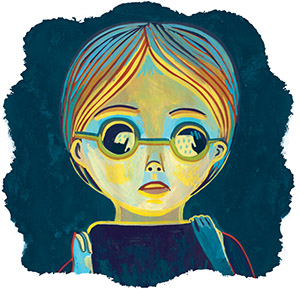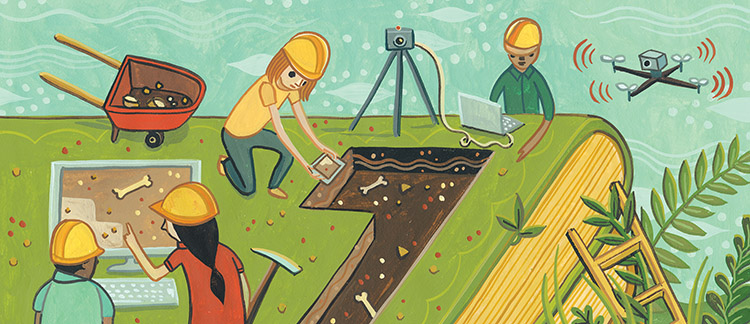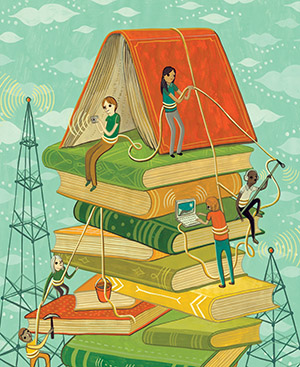Experts and teaching alumni talk high-tech classroom delivery and pen and paper understanding.

The enraptured child, his face aglow in an iPad’s electronic shadow, watches another father and son play with colorful plastic superheroes in a YouTube video. A sixth grader tries to convince his mother that the hour spent in front of the television maneuvering through Minecraft is homework. And a freshman teenager, her smartphone seemingly extended from her thumb-typing soul, checks into a Hobbit chatroom for rumors and news from Middle-earth. For Pete’s sake, does anyone read books anymore?
The short answers to both questions — from headline and preceding sentence — are of course, no to extinction and yes, of course people read books. In spite of an onslaught of digital technologies emerging in classrooms and homes, the traditional hardbound book is not disappearing anytime soon (regardless of any online obituary you may have recently read). The ways children learn, however, from preschool beginnings through secondary senior days, point to a learning curve that could make any educational efforts from last century look downright prehistoric.
The following seven sources all have a stake in today’s young learner, along with what makes for the best instruction practices. From researchers working on the front end of parenting education to technology drivers looking to transform the learning process, from experts in the College of Education to professional practitioners, each weighs in from a perspective that she or he knows best.
Technology traps and a book in hand
Judith Myers-Walls, professor emerita of human development and family studies, has made an academic career of helping parents better understand their children so they can teach them well. From her vantage point, there’s nothing new about parents trying to adapt to a potentially intimidating technological landscape. “There are always new media, new ways to package information and get it out there,” she says. “With each new medium, we’ve got to figure out how to use it. Generally speaking, the media are neutral, not good or bad. They can be used well or poorly.”
As anyone who’s ever sought emoji advice from a texting teen knows, offspring are often light years ahead of their begetters when it comes to new media. “Children have less relearning to do, so they learn to think in the ways facilitated by those media,” Myers-Walls says. “It’s amazing what two- and three-year-olds can do with computers and phones. Growing up with the technology, they are in tune with it.”
This role reversal has a way of upsetting the power balance in families because parents expect to know more for teaching purposes. Myers-Walls likens this to immigrant families where children may know the language much better than parents. This knowledge tilt may allow the kids to be in control in some ways as parents are pushed beyond technical comfort zones.
On the flip side of that is a child who can explain to parents the technological concepts, such as the geometric objectives of Minecraft, to gain a better understanding for himself. “We need to look at the ways that parents help their kids learn,” Myers-Walls says. “Their major role is to facilitate learning and encourage motivation, not to do all the teaching. Parents need to teach certain things, such as basic values, the family’s history, or even a certain craft. But the primary role should be helping kids learn how to manage information.”
Melanie Kuhn, the Jean Adamson Stanley Professor in Literacy, looks at how we best process that information when it comes to the written word — whether it’s on a tablet screen or within the pages of a book. She points to two recent studies, one in Europe and another in the US, that suggest reading on paper and taking notes by hand offer advantages over digital reading and note-taking.
“At the most basic level, comprehension is better when you’re reading actual books or reading via paper,” Kuhn says. “I think we’re generally more distracted the way we read online, perhaps reading one thing and then clicking onto something else.”
As for reasons why retention is better with longhand notes, even when a student could perhaps transcribe a lecture verbatim on her laptop, Kuhn says it’s the tactility of the exercise. “The actual physical process of taking notes contributes to the understanding.”
Similarly, she says her own Purdue students, future teachers, prefer books for their ability to hold something with a spine, smell the pages, and even enjoy the bookstore experience of browsing titles by subject matter. That’s not to say, however, that Kuhn or her students are anti-technology. Most assignments begin with an online search for articles, and the encyclopedic knowledge within arm’s reach can be very handy.
“There are really important ways to use the Internet,” says Kuhn, who also teaches a unit on using technology effectively in the classroom. “You need to make sure what you’re doing is unique. If you have a smartboard and you want to show students what ‘gilded’ is, you can show them immediately through a picture. Or you could have them look up multiple websites to gather and weigh evidence of global warming.”
Given the subject of the book’s potential demise, Kuhn may have been thinking of Mark Twain, who wrote of the Gilded Age in US history and once famously refuted his own reported death. “Whenever a new technology platform comes along, someone declares books dead,” she says. “That’s simply not true. They survived the radio and television. You can’t game with the rest of the world through a book, but you can find yourself in a different world through a book.”
STEM facts and fictions
A longtime lover of literature and books, William Watson, associate professor of learning design and technology and director of Purdue’s Center for Serious Games and Learning in Virtual Environments, didn’t join the dark side by embracing the technology that hopes to meet students halfway. For the better part of this century, he’s just been trying to design more engaging instructional environments.
“I grew up playing games,” Watson says. “When you play a video game, you’re learning. It’s just that what you’re typically learning is how to win that particular game. If we make educational video games that are tied to learning, we’re going to achieve those desired outcomes.”
Watson’s broader research focuses on meeting the needs of today’s students. “That means lessons are more personalized,” he says. “They’re focused on individuals learning, rather than standardizing everything and being driven by time.”
By implementing games into classrooms and guiding teachers toward best digital practices, Watson is hoping to strengthen the role of the classroom facilitator. “What we don’t necessarily need any more is the instructor to be the content deliverer meaning I’m going to lecture and provide you with all the information,” he says. “We need teachers to maximize the efficacy of the learning process. Technology can transform education into something that is more learner-centered.”
Carla Johnson, professor of science education and associate dean for research, engagement, and global partnerships, arrived at Purdue three years ago with a reputation for boosting STEM (science, technology, engineering, and math) centers at universities. She’s since worked with 25 STEM-focused Indiana schools, many of which are infusing “one-to-one” technology (meaning one technological device per student) in classrooms while providing teacher training.
Prior to Purdue, Johnson led a project with Duke Energy to turn a fourth-grade classroom in Kentucky completely green with iPads instead of books. She also works with the technology-enabled Maconaquah School Corporation in Bunker Hill, Indiana, which effectively eliminated winter snow days by having teachers and students “attend” classes from home. Perhaps also reducing the number of sledding accidents on Bunker Hill hills.

“The technology brings the student a wealth of information that may not be accessible, or up to date, through books,” Johnson says. “But I believe smart classrooms should include a combination of books and technology.”
Johnson says one of the most significant equity issues in schools today is the access to technology. Research suggests that many of the students who are eventually “left behind” simply don’t get that digital jumpstart.
“If you talk to employers like Eli Lilly and Procter and Gamble, they’ll tell you the number one thing students lack is the mastery of 21st century skills,” Johnson says. “That’s not just utilizing technology, but using critical thinking and problem solving skills, as well as being able to communicate well and collaborate with others.”
Janet Alsup, professor of English education, taught high school English for seven years, sometimes telling reluctant student readers that literature was good for them — like eating vegetables. Wanting to investigate more about teaching and learning, she earned her PhD and began exploring what has often been characterized as the culture wars between science and the humanities. Her latest book, A Case for Teaching Literature in the Secondary School: Why Reading Fiction Matters in an Age of Scientific Objectivity and Standardization, could provide a better answer for English teachers looking to hang the proverbial reading carrot in front of any STEM-minded student.
“I hesitate to set it up as a dichotomy,” Alsup says, “but I think over the past 20 to 25 years our society has valued science and technology over reading and literature, or the ‘soft skills,’ as some people say.”
Alsup says the corporate measuring stick, however, as Johnson also references, still places value on collaboration, communication, empathy, rhetorical listening, and analysis — all smarts that could be developed through reading literary fiction. And whether a student reads Shakespeare on a tablet or carries the anthologized weight of the bard’s world in a backpack, the heavy lifting in the humanities could pay off in a variety of careers.
Whether a student reads Shakespeare on a tablet or carries the anthologized weight of the bard’s world in a backpack, the heavy lifting in the humanities could pay off in a variety of careers.
Bridging learning gaps digitally
Jennifer Denton (EDU’93) has spent the last 21 years in the football heart of Texas, in Plano, about a half hour north of Dallas. She was named the 2015 Secondary Teacher of the Year in Plano for her work at Wilson Middle School, a surprising and significant honor to go along with a job she absolutely loves.
“I’ve always worked with students who have reading disabilities as a dyslexic therapist,” says Denton, who also works with students considered “at risk for failure” on a one-on-one basis.

Through multisensory instruction, Denton’s students gain access to audiobooks and various visual and auditory programs that allow them to see and hear words. “I’m still using books, though, especially when we do paired reading and then independent reading,” she says. “I’m old school that way.”
A combination of an “old school” passion for transforming lives and some 21st century technology has led to some remarkable turnarounds in a two-year program. “The students are very hesitant at first,” Denton says of the typical class that maxes out at six students. “By middle school, they know they’re behind their peers, often reading at only a third- or fourth- grade level. We have to build them up.”
Joanne Troutner (LA’47, MS LA’76) spent the bulk of her career close to her alma mater, building up young minds as a high school librarian, media specialist, and English teacher before becoming the technology director for the Tippecanoe School Corporation. Now in semi-retirement, she’s helping K-12 educators integrate technology into classrooms.
She prefers the word facilitation to training. “For educators, training is something you do to animals,” Troutner says. “I downplay the technology and ask what they’re trying to teach. What are we after and what do we want the kids to do? Then we just add a few more tools to what they already have.”
Just as any teacher has a classroom full of students with ranging abilities, Troutner now tutors teachers who span the spectrum of technological know-how — from novice to proficient. “One thing I always pose to them is to look at a different way to do a vocabulary assessment,” she says. “Instead of having kids write a sentence using words, let’s have them craft a collage of photos for a definition.”
Book reports fashioned into PowerPoint “book trailers,” like movie trailers, allow students to share ideas creatively, even discovering voices not tied to writing. Troutner says the dyslexic learner can use a specific device to make certain fonts more readable.
“Those are just a few examples of where the technology can improve upon the printed piece,” Troutner says. “It’s finding where the tech fits best. In the early days of technology integration, students would come in and we’d ask them to power down. With the one-to-one initiatives we’re seeing in a variety of school districts, we’re getting better about not doing that. And we’re using both print and electronic materials. Because there’s a place for both.”
William Meiners (MFA’03) is a freelance writer living in Mount Pleasant, Michigan. He is the founding editor of Sport Literate and owner of William Meiners Writing.

